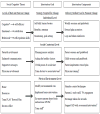Methods and baseline characteristics of a randomized trial treating early childhood obesity: the Positive Lifestyles for Active Youngsters (Team PLAY) trial
- PMID: 22342450
- PMCID: PMC3336873
- DOI: 10.1016/j.cct.2012.02.003
Methods and baseline characteristics of a randomized trial treating early childhood obesity: the Positive Lifestyles for Active Youngsters (Team PLAY) trial
Abstract
There are few effective obesity interventions directed towards younger children, particularly young minority children. This paper describes the design, intervention, recruitment methods, and baseline data of the ongoing Positive Lifestyles for Active Youngsters (Team PLAY) study. This randomized controlled trial is designed to test the efficacy of a 6-month, moderately intense, primary care feasible, family-based behavioral intervention, targeting both young children and their parent, in promoting healthy weight change. Participants are 270 overweight and obese children (ages 4 to 7 years) and their parents, who were recruited from a primarily African American urban population. Parents and children were instructed in proven cognitive behavioral techniques (e.g. goal setting, self-talk, stimulus control and reinforcement) designed to encourage healthier food choices (more whole grains, fruits and vegetables, and less concentrated fats and sugar), reduce portion sizes, decrease sweetened beverages and increase moderate to vigorous physical activity engagement. The main outcome of this study is change in BMI at two year post enrollment. Recruitment using reactive methods (mailings, TV ads, pamphlets) was found to be more successful than using only a proactive approach (referral through physicians). At baseline, most children were very obese with an average BMI z-score of 2.6. Reported intake of fruits and vegetables and minutes of moderate to vigorous physical activity engagement did not meet national recommendations. If efficacious, Team PLAY would offer a model for obesity treatment directed at families with young children that could be tested and translated to both community and primary care settings.
Copyright © 2012 Elsevier Inc. All rights reserved.
Figures


References
-
- Daniels SR, Arnett DK, Eckel RH, et al. Overweight in children and adolescents: Pathophysiology, consequences, prevention, and treatment. Circulation. 2005;111(15):1999–2012. - PubMed
-
- Freedman DS, Dietz WH, Srinivasan SR, Berenson GS. The relation of overweight to cardiovascular risk factors among children and adolescents: The Bogalusa heart study. Pediatrics. 1999;103(6 Pt 1):1175–1182. - PubMed
-
- Must A, Strauss RS. Risks and consequences of childhood and adolescent obesity. Int J Obes Relat Metab Disord. 1999;23 (Suppl 2):S2–11. - PubMed
Publication types
MeSH terms
Grants and funding
LinkOut - more resources
Full Text Sources
Medical

